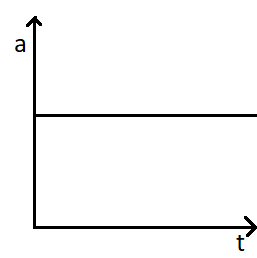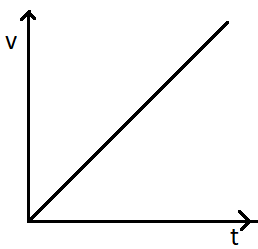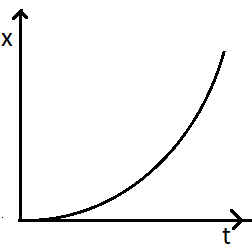
Corresponding to the acceleration time graph given below, draw x-t and v-t graphs.


Answer
539.4k+ views
Hint Since the acceleration is constant with time so the velocity is increasing at a constant rate. Thus from there we can draw the v-t graph. From the equation of motion we can see that the equation for position is quadratic in time so the graph will be parabolic.
Formula Used: In this solution we will be using the following formula,
$\Rightarrow x = ut + \dfrac{1}{2}a{t^2} $
where $ x $ is the position, $ u $ is the initial velocity, $ a $ is the acceleration and $ t $ is the time.
Complete step by step answer
In the question we are given the graph of the acceleration with respect to time. In the graph we can see that it is a straight line which is parallel to the time axis. This means that the acceleration remains constant with time.
Now for a velocity time graph, the slope is given by $ \dfrac{{dv}}{{dt}} $ . Now the differentiation of velocity with respect to time gives us the acceleration. So we can write,
$\Rightarrow \dfrac{{dv}}{{dt}} = a $
On integrating we get,
$\Rightarrow v = u + at $
where the initial velocity can be taken as $ u = 0 $ for time 0. Hence we see that the velocity is directly proportional to the time. So the graph will be a straight line passing through the origin for $ u = 0 $ .
That is,

Now for the position time graph, again, the acceleration is the double differentiation of the position. So we can write,
$\Rightarrow \dfrac{{{d^2}x}}{{d{t^2}}} = a $
On integrating twice we get,
$\Rightarrow x = ut + \dfrac{1}{2}a{t^2} $
If the initial velocity is considered to be zero, for time zero, we get,
$\Rightarrow x = \dfrac{1}{2}a{t^2} $
From here we can see that the position is a quadratic equation of time and represents the form of a parabola. So the graphical representation will be,

Note
Using the velocity time graph we can find both the acceleration and the displacement of the particle. The slope of the velocity time graph given the acceleration and the area covered under the velocity time graph gives the displacement of the particle.
Formula Used: In this solution we will be using the following formula,
$\Rightarrow x = ut + \dfrac{1}{2}a{t^2} $
where $ x $ is the position, $ u $ is the initial velocity, $ a $ is the acceleration and $ t $ is the time.
Complete step by step answer
In the question we are given the graph of the acceleration with respect to time. In the graph we can see that it is a straight line which is parallel to the time axis. This means that the acceleration remains constant with time.
Now for a velocity time graph, the slope is given by $ \dfrac{{dv}}{{dt}} $ . Now the differentiation of velocity with respect to time gives us the acceleration. So we can write,
$\Rightarrow \dfrac{{dv}}{{dt}} = a $
On integrating we get,
$\Rightarrow v = u + at $
where the initial velocity can be taken as $ u = 0 $ for time 0. Hence we see that the velocity is directly proportional to the time. So the graph will be a straight line passing through the origin for $ u = 0 $ .
That is,

Now for the position time graph, again, the acceleration is the double differentiation of the position. So we can write,
$\Rightarrow \dfrac{{{d^2}x}}{{d{t^2}}} = a $
On integrating twice we get,
$\Rightarrow x = ut + \dfrac{1}{2}a{t^2} $
If the initial velocity is considered to be zero, for time zero, we get,
$\Rightarrow x = \dfrac{1}{2}a{t^2} $
From here we can see that the position is a quadratic equation of time and represents the form of a parabola. So the graphical representation will be,

Note
Using the velocity time graph we can find both the acceleration and the displacement of the particle. The slope of the velocity time graph given the acceleration and the area covered under the velocity time graph gives the displacement of the particle.
Recently Updated Pages
Master Class 11 Chemistry: Engaging Questions & Answers for Success

How many 5 digit telephone numbers can be constructed class 11 maths CBSE

Draw a well labelled diagram of reflex arc and explain class 11 biology CBSE

What is the difference between noise and music Can class 11 physics CBSE

A current I is flowing through wire PQR This wire is class 11 physics CBSE

Find the plane of symmetry center of symmetry and axis class 11 chemistry CBSE

Trending doubts
What is the difference between lightdependent and lightindependent class 11 biology CBSE

1 Quintal is equal to a 110 kg b 10 kg c 100kg d 1000 class 11 physics CBSE

Draw a diagram of nephron and explain its structur class 11 biology CBSE

Swaraj means AComplete Independence B Self rule C Self class 11 social science CBSE

Write the differences between monocot plants and dicot class 11 biology CBSE

Difference Between Prokaryotic Cells and Eukaryotic Cells




